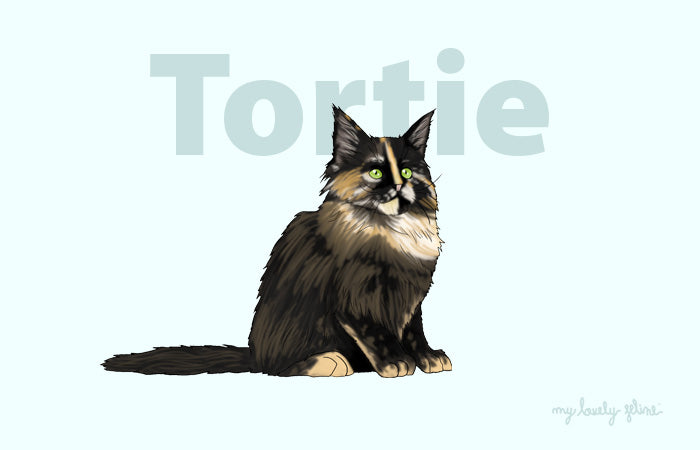—Feline Behavior Specialist 🇺🇸
|
Tortoiseshell cats or torties have gorgeous orange and black coats that demand attention. They’re also said to be full of attitude, fiercely independent, and total divas but is tortitude an actual thing? What makes them different from calicos? Are they always female? You’re about to learn why there’s so much to love about torties. |
What is a tortie?
Tortie cats are black/brown with orange/red. If the colors display with a tabby pattern, the cat is called a torbie.
What’s the difference between a tortie and a calico?
Calicos have orange and black with white. Torties do not have any white.
Is tortie a breed?
No, it’s a color and pattern. Common breeds with torties include American Shorthair, British Shorthair, Persian, Cornish Rex, Ragamuffin, and Maine Coons.
What genetically determines a cat will be a tortie?
Females carry XX chromosomes, and males XY.
The orange color gene is only on the X chromosome, and it can present two ways: orange or non-orange which is black. What it basically means is the gene tells cells, “Go orange!” or “Go black!”
If a male has the orange gene on the X chromosome, the gene tells the cells, “Go orange!” If he has the non-orange gene, that gene says, “Go black!” The color gene is not connected to the Y, so the male can only have the color on the X chromosome of orange or black, not both.
Because females have XX, they can carry orange on one X and non-orange on the other X, meaning they will present with orange and black fur and be a tortie.
In the rare case a male is a tortie, he has an extra chromosome, carrying XXY. It’s the same as females where one X says “Go orange!” and the other “Go black!” This is more of a genetic oopsie which makes the male tortie (or calico) always sterile.
These males often suffer from Klinefelter’s Syndrome, which can lead to medical issues like cognitive and developmental issues; frail bones; higher body fat leading to heart disease, arthritis, and diabetes; and a shorter lifespan.
What patterns can torties display?
They can be patched with patches of color, or if the colors look woven together, it’s called brindled.
Some tortoiseshell cats have what looks like a split face down the middle. What causes this?
Although there is a lot of discussion around this being from chimera, when two fertilized eggs combine into one organism in utero, some scientists dispute this because the split face is actually most often the result of a normal tortoiseshell pattern.
They do agree, however, that it is possible male torties are the result of chimera, and their coloring is more from a combo of two sets of genetics than just the extra chromosome.
This is all still up for debate, but split faces in tortie females are most likely not the sign of a chimera, and is just a normal tortie pattern variation.
What color eyes do torties have?
Most commonly green or orange.
How long do torties live?
As mentioned earlier, the rare male might have a shorter lifespan, but female indoor torties live an average of 14 years.
What are their personalities like?
Just like calicos, most feedback is anecdotal and not based on research. While many people say their torties have a fair amount of attitude, there isn’t research to back it up. However, there is research that supports the idea that male cats are more laid back than females.
Are tortie cats considered good luck?
That and so much more. Here are a few beliefs from around the world:
-
Ireland and Scotland - A male tortie entering the home is seen as good luck.
-
English Folklore - Rub a tortie’s tail on a wart to make it go away.
-
United States - Called money cats, torties bring fortune to the home, have psychic abilities and can see into the future.
-
Southeast Asia - Torties were created from the blood of a young goddess.
- Japan - Like their calico counterparts, Japanese fishermen think bringing a tortie on a boat will protect them from storms and ghosts.
Besides Klinefelter’s Syndrome in rare tortie (and calico) males, are there any diseases that seem to be genetically tied to torties?
No, there aren’t, however, their color coat can make it difficult to spot issues with their skin, including fleas and ticks. To keep an eye on things, brush your cat once a week and always stay up to date on flea and tick meds.
According to Merck Veterinary Manual, the most commonly reported congenital and inherited defects in cats are:
-
Cerebellar hypoplasia (CH) aka Wobbly Kitten Syndrome - Underdeveloped cerebellum (which controls mobility and balance)
-
Eye and eyelid defects
-
Heart defects
-
Cryptorchidism - One or both testicles absent
- Polydactyl - Extra toes
In Closing
Whether tortitude is an actual thing or just a myth, we still love torties. Their gorgeous coat colors and unique patterns will always turn heads. Even if they don’t actually bring fortune to our homes, they undoubtedly bring love, which is more than enough for us.Sources:
TheSprucePets.com, 7 Tortoiseshell Cats and Kittens.
Caster.com, 7 Fascinating Facts About Tortoiseshell Cats.
Nationwide, PetHelathZone, Tortoiseshell Cats.
FelineLiving.net, Tortoiseshell Cats – Facts, Genetics and Personality.
GoodHousekeeping.com, 10 Fascinating Facts About Tortoiseshell Cats.
MessyBeast.com, Cat Chimeras.
Article by Elizabeth Italia 🙋♀️
Cat Behavior & Fostering Specialist



